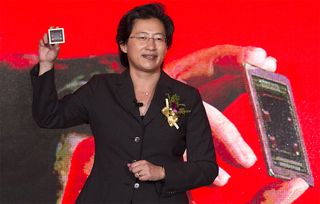AMD reaffirms commitment to gaming, discusses Intel partnership
AMD CEO Dr. Lisa Su says AMD's commitment to gaming is not going to change.

Looking back at 2017, it was a busy year for AMD. The company launched new CPU and GPU architectures, it lost its graphics boss Raja Koduri, and it partnered with Intel on a Core processor with custom Radeon graphics. So, what's next? The folks at AnandTech posted an interview with AMD CEO Dr. Lisa Su, who talked a little about AMD's future plans.
As it pertains to gaming, there is some uncertainty surrounding AMD. Koduri was a big loss, and AMD just yesterday filled the vacancy at the top of its graphics division with two industry veterans—Mike Rayfield, who led the team that created Tegra at Nvidia, and David Wang, who has a long and impressive resume.
Dr. Su did not talk about the recent hires directly, though she made an interesting comment about the company's GPU efforts, and having more than one team involved.
"On the GPU side, we have multiple teams that are looking at how to improve the instruction set as you go forward and I would say that we are thinking on the compute aspect of GPUs. How do we think about sort of the traditional GPU engines to special accelerators, things like that," Dr. Su said.
AnandTech followed this up with a question asking if there is room in the future for GPU bifurcation between a gaming focus and a compute focus.
"I think there is. You will see us move on this, and we're very committed to gaming so that's not going to change, but you will see us do some more purpose-built products for the compute side of things," Dr. Su said.
We wish AnandTech would have asked Dr. Su about the graphics shortage caused by cryptocurrency mining and if AMD is doing anything about it. Instead, Dr. Su talked about the recent partnership with Intel to infuse Radeon graphics with Intel's Core processors.
PC Gamer Newsletter
Sign up to get the best content of the week, and great gaming deals, as picked by the editors.
"There are some people who might think it is an odd relationship but I think the relationship is representative of the world we live in today. Today it is very much around the fact that you can compete in some areas and you can partner in other areas. In this particular case, the way we looked at it is whether it would expand the market for Radeon," Dr. Su said.
"I think Intel had an interest in using a Radeon graphics custom chip, and we’re selling silicon, and as a result we saw it as a positive for us. Obviously there are areas that we are going to continue to compete very fiercely, and in this area, we are going to partner," Dr. Su added.
That fierce competition she references has mostly played out on the CPU side, but with Intel indicating an interesting in building its own discrete graphics solution, things could get very interesting in the coming years.
Dr. Su also addressed HBM2 memory in the interview, and whether it is too expensive to use in mid-range products. According to Dr. Su, while there is a "real tightness" in the memory market as a whole right now, she believes that "over time we'll see it become more cost effective." She covered a lot more topics in the interview, check it out when you have a moment.
Paul has been playing PC games and raking his knuckles on computer hardware since the Commodore 64. He does not have any tattoos, but thinks it would be cool to get one that reads LOAD"*",8,1. In his off time, he rides motorcycles and wrestles alligators (only one of those is true).
Most Popular








